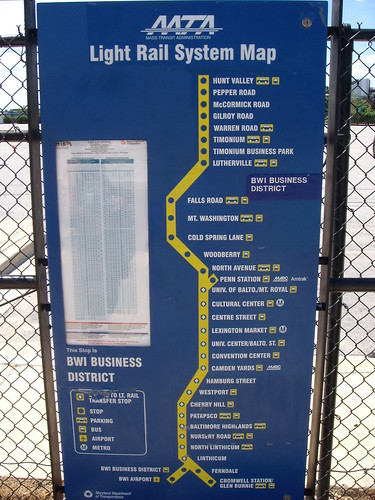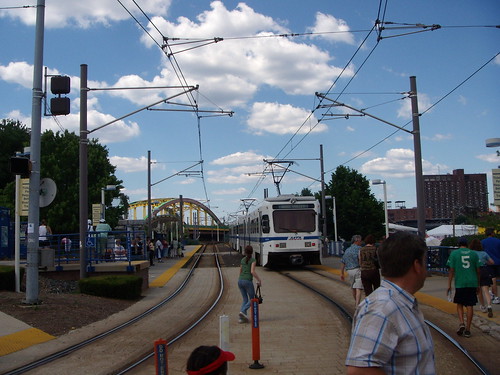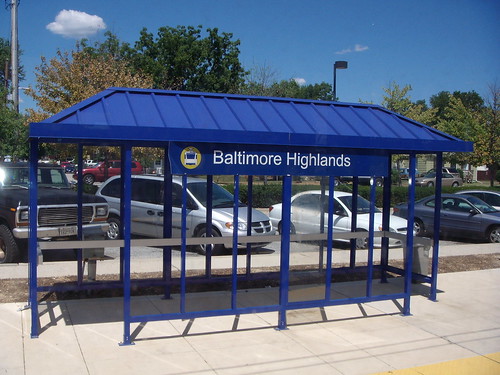 A woman tends to her yard behind the Nursery Road station on Baltimore's light rail. Check out this slideshow comparing Charm City's trains to the potential Purple Line.
A woman tends to her yard behind the Nursery Road station on Baltimore's light rail. Check out this slideshow comparing Charm City's trains to the potential Purple Line.You might scoff at Baltimore's single light-rail line, but it gives Washington-area transit riders a good idea of what the proposed Purple Line will look like if the Maryland Transit Administration - which runs Baltimore's light rail and subway - decides to use the same technology here. A friend and I rode the rails from the BWI Business District station in Linthicum into Baltimore for Artscape, a yearly art festival, to avoid parking - but also to catch a glimpse of our possible future.
so much more AFTER THE JUMP . . .
History
 The Baltimore light-rail first began service in 1992 between Timonium, north of the city, and Glen Burnie to the south. In 1997, the line was extended further north to Hunt Valley along with spurs to BWI Marshall Airport and Penn Station. Originally, the entire system had a single track, severely limiting the number of trains the system could run at a given time and stifling ridership. A second track was added last year. Today, the light-rail averages 36,000 passengers a day.
The Baltimore light-rail first began service in 1992 between Timonium, north of the city, and Glen Burnie to the south. In 1997, the line was extended further north to Hunt Valley along with spurs to BWI Marshall Airport and Penn Station. Originally, the entire system had a single track, severely limiting the number of trains the system could run at a given time and stifling ridership. A second track was added last year. Today, the light-rail averages 36,000 passengers a day.While the Washington Metro's been responsible for revitalizing neighborhoods throughout the region, Baltimore's light rail has been relatively less successful, possibly because it covers such a limited area. It also doesn't connect with the city's single subway line - a major concern for Purple Line skeptics who worry about messy transfers between it and the Red, Green and Orange lines.
 People cross the tracks as a train approaches near the Mount Royal station.
People cross the tracks as a train approaches near the Mount Royal station.Right-of-Way
Simply put, if you hopped off the platform at a Metro station and touched the third rail, you would die. Not so in Baltimore: the light-rail gets its power from overhead wires called a catenary. This enables light-rail lines to be placed at-grade; on Baltimore's system, it runs in the street through the city and on regular train tracks in the suburbs. The catenary wires are visible, but no more visually distracting than telephone wires or streetlights or anything else you'd expect to see in an urban or suburban street.
Where the tracks intersect with a street, gates are lowered to prevent cars from running into the train. This doesn't occur in the city; the trains have special lanes with some sort of barrier between them, but they use the same stoplights as everyone else. One downside to this is that trains WILL stop at every light, slowing the trip through Baltimore into an interminable crawl.
Like the Georgetown Branch in Chevy Chase, the rights-of-way north and south of the city was originally used for freight trains and streetcars. At about thirty feet from end to end, it's only as wide as it has to be, and it appears that the homes and neighborhoods adjacent to the line were not disturbed by the train's operation. We saw kids playing in yards and people tending to gardens pretty much oblivious to the trains rushing past them.
Stations
 Even smaller Metro stations like Forest Glen have large platforms, elevators and escalators, and acres of parking. Meanwhile, the Baltimore Highlands station just south of the city consists solely of a bench and a ticket machine under a shelter. There's a park-and-ride lot, but it's small. (Keep in mind that the Purple Line may not even have park-and-ride lots.) The distance from the platform to the nearest house is less than half a block.
Even smaller Metro stations like Forest Glen have large platforms, elevators and escalators, and acres of parking. Meanwhile, the Baltimore Highlands station just south of the city consists solely of a bench and a ticket machine under a shelter. There's a park-and-ride lot, but it's small. (Keep in mind that the Purple Line may not even have park-and-ride lots.) The distance from the platform to the nearest house is less than half a block.The neighborhoods the light-rail serves both in and outside of Baltimore were built around streetcars - much like Chevy Chase and Takoma Park, two towns the Purple Line will stop in. In these older communities, there were a lot of mature trees. We were surprised by how thick the tree cover was along the right-of-way and at some stations. The North Linthicum station, especially, appeared to be in a well-forested area.
Trains
 Baltimore's trains are unusually large for light rail vehicles. While that means they're a little more comfortable inside than the smaller streetcars used in Boston or Toronto, it also means they can overwhelm their surroundings. A three-car train is nearly three hundred feet long, which could snarl traffic on some of Downtown Silver Spring's shorter blocks.
Baltimore's trains are unusually large for light rail vehicles. While that means they're a little more comfortable inside than the smaller streetcars used in Boston or Toronto, it also means they can overwhelm their surroundings. A three-car train is nearly three hundred feet long, which could snarl traffic on some of Downtown Silver Spring's shorter blocks.Nevertheless, the view from inside a light rail train is commanding. (Take that, SUV owners.) Passengers can actually see what's on a street, giving them more of an incentive to get off and look around. We rode into Baltimore the weekend of Otakon, a major anime convention held at the Baltimore Convention Center, and the sidewalks were filled with cosplayers (people dressing up as anime characters).
The train's height comes at a disadvantage: the platforms aren't high, so passengers have to climb stairs to board the train. MTA is bound to have accomodations for handicapped riders, but they aren't easy to spot.
 Passengers wait for a train at the Cultural Center station.
Passengers wait for a train at the Cultural Center station.Convenience
We have to admit: the light rail is slow. Wikipedia suggests that trains have a maximum speed of 60 miles per hour - comparable with Metro's - but due to the number of stops on the line and a lack of special timing at intersections, the ten-mile trip from BWI to the Mount Royal station took forty minutes.
A rush-hour trip on the J4 Metrobus takes fifty-seven minutes to go from College Park to Bethesda, a distance of about ten miles. Light-rail may not be fast, but it would still beat the bus.
Remaining Questions
Obviously, our experiment leaves a lot of questions to be asked. What's ridership like on a weekday? Are riders willing to transfer between the light rail and other modes of transportation (car, bus, subway, commuter train)? Baltimore's system also doesn't have the added requirement of accomodating a trail next to the tracks. What's it like biking next to the light-rail train? It looks like we might have to do some more research.
Heads-up to Scott Kozel's Roads to the Future for enlightening us on the history of Baltimore's light rail.

20 comments:
Wow those light rail trains are so sleek and elegant. They are downright futuristic.
Anonymous said...
Wow those light rail trains are so sleek and elegant. They are downright futuristic.
RE: You must not have seen the new photos of the light rail system in Charlotte, NC......
It makes the light rail in Baltimore look like a cheap updated version of a trolley.
The first comment was sarcasm. The Baltimore Light Rails cars look like they could have been featured in the 50's Sci Fi classic "Earth vs. the Flying Saucers".
Anonymi: Is it so hard to pick a name/identity? You are defeating the purpose of communication through blogs.
Yeah, "anonymous" is not cool - post under your name or be quiet ;-)
One thing I'll say for Balt Light Rail is it IS quiet - and compared to those loud-ass diesel Metro and Rideon buses around here, they are wonderful - so one can say living near it is a noise distrubance.
washingtongardener:
My grandfather used to say that there is nothing worse than a dirty mouthed woman. So there you go.
Why don't you be quiet with your vulgarity.
C'mon, guys. Don't make me re-instate that ban on anonymous posting from last year.
First-- Let's try to be civil, in our comments to each other.
Second-- As one who is opposed to the Purple Line, too little too late and too expensive, I must agree that the Baltimore Light rail is nice-- but the Purple Line is just an over-rated ov er-privced boondoggle that should have been built years ago as a hub of the current Metro.
Too many of our planners obviously do not plan for the future, if they had used a little foresight perhaps they would have seen the over crowded conditions arriving .
I'm Purple line all the way. I like the idea of getting to Bethesda in under 20 min., in something less packed than the J2 bus. I chose to live (renter) in Downtown Silver Spring because the Metro train and buses here, run the times I need for commuting to work. Not needing a car,(gas, insurance, payments, parking, maintainance) makes Silver Spring more affordable than places outside this Public-Transit Nexus. The b is Purple.
WashingtonGardener said...
Yeah, "anonymous" is not cool - post under your name or be quiet ;-)
RE: Thats just your way of saying that you can't handle the truth as to what people have to say against your BS reasonings of wasting $Millions on a Sorry Ligh Rail Trolly that will do nothing but replce the existing Bus Routes......
WashingtonGardener said...
One thing I'll say for Balt Light Rail is it IS quiet - and compared to those loud-ass diesel Metro and Rideon buses around here, they are wonderful - so one can say living near it is a noise distrubance.
RE: If that were true then Virginia would be in the process of Building a Light Rail to Loudon County via Dulles Airport instead of a Mordern High Speed Heavy Rail Subway..........
Anon -
Thanks for my belly laugh of the week - clearly you are the new Stephen Colbert! Took me awhile to get it, but I see now you are cleverly trying to skewer the anti-PL folks by pretending to be one of them then posting hilariously inane and idiotic anonyomous blog comments thus making them all look like fools. That is very clever though not very nice. I'll take the high road and participate no further - will just sit back to read your further blog post parodies.
What will the above ground light rail Purple Line accomplish?
a) It will remove traffic from 495 and East West Highway.
b) It will provide a more inexpensive method for low wage workers to commute to their jobs.
c) It will cure cancer.
d) It will place a poorly thought out 60' wide cement highway over a beautiful and widely used greenspace while not helping to solve the regions traffic problems.
You are right the answer is d).
Now let's get this thing built, time is a wastin.
Does anyone know what type of cars they plan on using on this project? Hopefully they won't be those hideous Baltimore Light Rail cars.
That's a great question. Since the Purple Line is being managed by the MTA, chances are they could opt to use the same cars currently used in Baltimore. That's good because we know they work, but, well, they aren't . . . sexy.
In my talk with Wayne Phyillaier, he suggested that the state may use a newer design - one that's a little quieter and smaller. Personally, I'd love to see cars like the ones in Houston, but they might also try to match D.C.'s streetcars that will be running in a year or two.
anonymous: _uck you. (or us, I guess...)
Dan and Sin -
The type of cars and size are very much in debate now - ACT has an upcoming meeting where the various car types will be presented so we can learn about the various options. You are all welcome to attend - it is free and open to the public. http://www.actfortransit.org/
Nice piece, but if the Baltimore line is the model, then the purple line is f***ed... How about the light rail (trams) in Bordeaux, Lyon, or Paris?
The LR vehicles in Baltimore and Portland, Oregon are dowdy. The Citadis vehicles from Alstom are pretty damn sexy.
Has monorail/monobeam technology been considered in this area??
See:
http://mvmi.org
http://www.monorails.org
http://www.otg-inc.com
http://www.futrexinc.com
Note that Baltimore's light rail transit (LRT) system is generally considered a failing system. The ride time along the Baltimore LRT tends to be longer than driving. During design, right-of-way constraints (generally arising out of political issues) forced designers to create numerous 5 and 10 MPH curves -- killer for a competitive transit system.
To find more appropriate light rail systems, Boston or Portland may make for a more educational trip; or if you really want to see good systems: travel abroad.
Note that the Purple Line is not anticipated to be heavy rail (which is what Metro is) due to cost constraints: heavy rail is MUCH higher than that of light rail. Additionally, monorail is not being considered as that is even more expensive than heavy rail: the cost-benefit is very poor without an extremely high density customer base to support it -- and Maryland's DC suburbia certainly does not provide adequate demand.
That's ridiculous -how could monorail be more expensive than heavy rail? Heavy rail requires relocation of lots of public utilities, massive boring through solid earth and massive structural reinforcement and uses steel wheels on steel track which wears quickly and must be constantly replaced.
Monorail quickly drops into place on prefabricated support columns that nimbly fit where no light or heavy rail could, and prefabricated beam sections that fit nicely into any environment and can be finished to neatly match as well. By comparison to either other rail option the on-site construction time and the environmental impact is practically zero. The rails and power supply are not exposed to the elements and so require far less maintenance. The trains are not exposed to at-grade car traffic and stop lights so they arrive much more quickly and with less energy expenditure than either other rail option so they can carry more passengers per hour and are more enticing to ride (plus they provide a nicer view for commuters). As a result they will attract even more ridership than can be expected for either other rail option. Existing monorail systems in Japan even turn a profit - UNLIKE OUR METRO SYSTEM WHICH REQUIRES 50% GOVERNMENT SUBSIDIZATION. Monorail is certainly the most cost effective option. Fear of something new is the only reason it's not being considered. But then it's not that new either - Monorail has been successfully employed in Germany for over 100 years!
Post a Comment